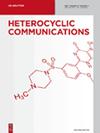铑配合物通过C-H键活化催化苯甲醛衍生物与苯乙炔的氧化偶联
IF 1.5
3区 化学
Q3 CHEMISTRY, ORGANIC
引用次数: 1
摘要
摘要本文报道了铑(Rh)催化剂在苯乙炔和苯甲醛衍生物之间通过C-H键活化的氧化偶联反应中的应用。这些反应由Rh(l-氨基酸)(cod)(l-氨基酸是l-苯丙氨酸、l-缬氨酸或l-脯氨酸;cod是1,5-环辛二烯)催化,以12.7–88.3%的产率获得色酮。这些新型铑催化剂对苯乙炔与不同苯甲醛衍生物之间的偶联反应具有优异的活性。发现苯甲醛衍生物取代基的电子效应影响反应产率,这与所提出的机理一致。本文章由计算机程序翻译,如有差异,请以英文原文为准。
The oxidative coupling between benzaldehyde derivatives and phenylacetylene catalyzed by rhodium complexes via C-H bond activation
Abstract This paper reports the use of rhodium (Rh) catalysts for the oxidative coupling reaction between phenylacetylene and benzaldehyde derivatives via C-H bond activation. These reactions were catalyzed by Rh(l-amino acid)(cod) (the l-amino acid is l-phenylalanine, l-valine or l-proline; cod is 1,5-cyclooctadiene) to obtain chromones in 12.7–88.3% yield. These new Rh catalysts have excellent activity for the coupling reaction between phenylacetylene and different benzaldehyde derivatives. It was found that the electronic effects of the benzaldehyde derivative substituent affected the reaction yield, which is in accordance with the proposed mechanism.
求助全文
通过发布文献求助,成功后即可免费获取论文全文。
去求助
来源期刊

Heterocyclic Communications
化学-有机化学
CiteScore
3.80
自引率
4.30%
发文量
13
审稿时长
1.4 months
期刊介绍:
Heterocyclic Communications (HC) is a bimonthly, peer-reviewed journal publishing preliminary communications, research articles, and reviews on significant developments in all phases of heterocyclic chemistry, including general synthesis, natural products, computational analysis, considerable biological activity and inorganic ring systems. Clear presentation of experimental and computational data is strongly emphasized. Heterocyclic chemistry is a rapidly growing field. By some estimates original research papers in heterocyclic chemistry have increased to more than 60% of the current organic chemistry literature published. This explosive growth is even greater when considering heterocyclic research published in materials science, physical, biophysical, analytical, bioorganic, pharmaceutical, medicinal and natural products journals. There is a need, therefore, for a journal dedicated explicitly to heterocyclic chemistry and the properties of heterocyclic compounds.
 求助内容:
求助内容: 应助结果提醒方式:
应助结果提醒方式:


